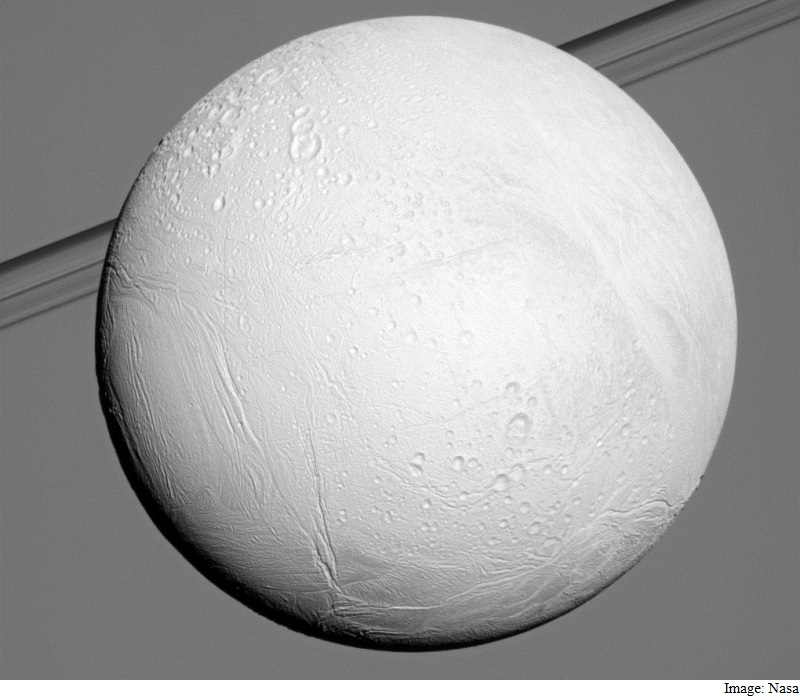- Home
- Science
- Science News
- Nasa's Cassini Probe to Fly Through Icy Spray of Saturn's Moon
Nasa's Cassini Probe to Fly Through Icy Spray of Saturn's Moon

An unmanned Nasa spacecraft is about to make its deepest dive ever into the icy spray emanating from the underwater ocean on Saturn's moon, Enceladus.
The tiny moon orbiting the sixth planet from the sun stunned scientists when they discovered it had an icy plume in 2005.
After years of observations, Nasa announced earlier this year that Enceladus definitely has a subterranean ocean, widening the search for alien life in our solar system.
While the Cassini probe's flyby on Wednesday will not be able to detect if there are life forms in the spray, scientists hope the close pass will give them new insight into the habitability of the extraterrestrial ocean.
"This daring flyby will bring the spacecraft within 30 miles (48 kilometres) of the surface of Enceladus's south polar region," Nasa said in a statement.
"The encounter will allow Cassini to obtain the most accurate measurements yet of the plume's composition, and new insights into the ocean world beneath the ice."
The flyby should take place at 3:22pm GMT on Wednesday, though the scientific data it collects may not be published for months.
Scientists hope that the trip will tell them how much icy material is emanating from Enceladus, and perhaps what kinds of complex organic molecules it contains, though not with enough detail to determine if anything is alive.
The $3.26 billion (roughly Rs. 21,179 crores) mission is a joint project by the US space agency, European space agency and Italian space agency.
Cassini is the first spacecraft to orbit Saturn, and it has been circling the planet since 2004.
It is making a series of flybys of Enceladus, including a final pass in December.
Catch the latest from the Consumer Electronics Show on Gadgets 360, at our CES 2026 hub.
Related Stories
- Samsung Galaxy Unpacked 2025
- ChatGPT
- Redmi Note 14 Pro+
- iPhone 16
- Apple Vision Pro
- Oneplus 12
- OnePlus Nord CE 3 Lite 5G
- iPhone 13
- Xiaomi 14 Pro
- Oppo Find N3
- Tecno Spark Go (2023)
- Realme V30
- Best Phones Under 25000
- Samsung Galaxy S24 Series
- Cryptocurrency
- iQoo 12
- Samsung Galaxy S24 Ultra
- Giottus
- Samsung Galaxy Z Flip 5
- Apple 'Scary Fast'
- Housefull 5
- GoPro Hero 12 Black Review
- Invincible Season 2
- JioGlass
- HD Ready TV
- Laptop Under 50000
- Smartwatch Under 10000
- Latest Mobile Phones
- Compare Phones
- OPPO Reno 15 Pro Max
- Honor Win RT
- Honor Win
- Xiaomi 17 Ultra Leica Edition
- Xiaomi 17 Ultra
- Huawei Nova 15
- Huawei Nova 15 Pro
- Huawei Nova 15 Ultra
- Asus ProArt P16
- MacBook Pro 14-inch (M5, 2025)
- OPPO Pad Air 5
- Huawei MatePad 11.5 (2026)
- Xiaomi Watch 5
- Huawei Watch 10th Anniversary Edition
- Acerpure Nitro Z Series 100-inch QLED TV
- Samsung 43 Inch LED Ultra HD (4K) Smart TV (UA43UE81AFULXL)
- Asus ROG Ally
- Nintendo Switch Lite
- Haier 1.6 Ton 5 Star Inverter Split AC (HSU19G-MZAID5BN-INV)
- Haier 1.6 Ton 5 Star Inverter Split AC (HSU19G-MZAIM5BN-INV)

















